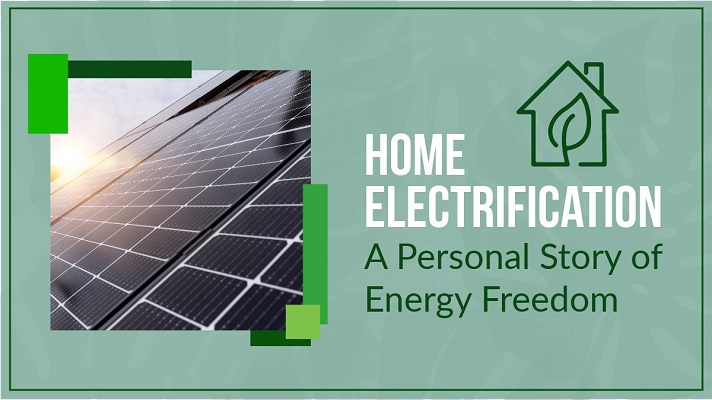
by Patricia Moore
We did it! After five years of gradually weaning our home off the methane pipe, we have finally achieved our ‘Electrify Everything’ goals.
For this article, rather than focusing on the science, statistics, and mechanics of home electrification, I wanted to highlight some personal observations from my own journey. My hope is that the more we share our lived experiences – the joys, challenges, and lessons learned – the faster we can break down barriers and build a cleaner, safer energy system for all.
Origin Story: Pre-Electrification
When we first moved into this 1500-square-foot house in 2016, it was not exactly a beacon of energy efficiency. With single-paned windows, drought-intolerant trees, sprawling lawns, and of course, gas appliances, it was pretty much what one might expect in a typical 30-year-old suburban dwelling.
During the first few years, we focused on lower-tech updates: replacing windows, redistributing insulation and ventilation, and growing a more ecologically sound landscape with native plants. We also used this time to adopt fun, creative, eco-friendly habits into our daily lives, such as biking and gardening.
Not only was the new lifestyle good for the planet and our own health, it also freed up some much-needed personal bandwidth and budget to begin preparing for the next big goal: Net Zero. (Or as close to it as possible.)
Project Basics
The entire home electrification process – from the first day of planning until the moment we turned off the gas valve – took about five years. The project included solar panels, inverters, battery storage, heat pump heater/air conditioner, heat pump water heater, and induction stove. Some steps also required peripheral modifications, such as installing outlets and rewiring electrical panels.
We hired professionals for about half of the projects. Because my partner has a background in electrical engineering, we were able to buy components and do some of the work ourselves. This helped save money, but it also took a little longer.
Results: TRUE Energy Freedom
Living in a fully electrified home powered by clean, renewable energy has opened up a dimension of freedom that far exceeded expectations. While the main goal was always to reduce our carbon footprint, I was pleasantly surprised to find so many immediate and tangible quality-of-life improvements. To name just a few:
Freedom #1: Free Electricity
Instead of paying hundreds of dollars every month, we now earn money from our own energy production. And without having to worry about rate hikes, time-of-use penalties, baseline-allowance restrictions, or other utility company shenanigans, we are free to live according to our own schedule and energy needs.
Freedom #2: Peace of Mind
Power outages, both planned and unplanned, are relatively common here in California. It’s a huge relief to know that no matter what’s going on with the grid,* we can keep the lights on (and perhaps more importantly, the wi-fi). This security also extends to our neighbors, friends, and family, who know they have a place to go if they ever need to plug in during a regional blackout.
*Please note, this benefit is only possible with batteries/inverters. On its own, solar power still requires a connected grid.
Freedom #3: Clean Air
Everybody should be able to fully enjoy that blissful smell of baking cookies – without also inhaling a bunch of methane, carbon monoxide, carbon dioxide, formaldehyde, and other byproducts of so-called “natural gas.” Electric appliances allow us to safely cook meals, bake cookies, run hot water, or turn on the heater, all without breathing in those invisible toxins.
Freedom #4: Constant Comfort
In addition to clean air, we can now keep the house fabulously comfortable at all times – it’s never too hot or too cold! The heat pump is more efficient and effective (at cooling and heating) than the clunky old HVAC unit. Who knew “room temperature” could be so luxurious?
Freedom #5: Forward Focus
Renewables will power the future, and this process has given us a jump-start on the next phase of energy systems. This house may have been built in the 80s, but the electric makeover has given it that fresh, new-home feel.
Challenges and Lessons Learned
While I am happy with what we have accomplished, the process was far from linear. From mild frustrations to potentially prohibitive roadblocks, we faced several challenges (and learned many lessons) throughout this journey.
Challenge #1: Costs
Estimates for labor and parts, as well as for the project scope itself, seemed to be all over the place. The quotes ranged from “yikes” to “nope” to “you’ve got to be kidding me.”
LESSONS LEARNED: Spend time researching all your options before signing any contracts. Get a wide range of different quotes, talk to people who have done this before in your area, and look into what kind of local, state, and federal rebates you might qualify for. Programs like Grid Alternatives and Rewiring America are also great resources to learn about potential cost-saving options.
Challenge #2: Expertise
It was hard to find professionals who were (1) experts in various home electrification options (including heat pumps, batteries, inverters, etc.), and (2) affordably priced, and (3) available within any foreseeable booking timeline.
LESSONS LEARNED: Ask for referrals from friends or neighbors who have electrified their homes. You can also check with a local advocacy organization or join an online forum for recommendations. This part of the process – finding and scheduling service providers – can take at least a few months.
Challenge #3: Red Tape
Permitting, inspections, and approvals can take a LOT of time. (Side note: We were surprised and disappointed to learn that fossil fuel companies are involved in some of the approval processes in the State of California.)
LESSONS LEARNED: Allow room for these kinds of chokepoints in your timeline. Although experienced home electrification professionals can help expedite the process, several expressed their own frustrations at having to deal with bureaucratic holdups. For DIY projects, however, permits and approvals can be especially tedious. Patience and persistence are key.
Challenge #4: Product Availability
Heat pumps, heat pump water heaters, and induction stoves did not seem to be as readily available as their gas-powered counterparts. Special ordering can add weeks, or even months to the overall transition process.
LESSONS LEARNED: Product delays should be baked (no pun intended) into your projected timeline. Our nifty little induction cooktop helped tide us over during the three-month wait for the new stove’s arrival.
Challenge #5: Product Compatibility
If you are piecemealing your project as we did, it’s critical to make sure every part, brand, and product will work together seamlessly, both now and in the future.
LESSONS LEARNED: Research, double-check, verify, and recheck compatibility across all your project components, as well as your home’s existing electrical capabilities, before committing to any particular brand or product. Ask the manufacturer or seller if they have any intention of changing their product’s compatibility options moving forward.
Conclusion
In my personal experience, the benefits of energy freedom have far outweighed the challenges. However, the process would have been exponentially more difficult without two income-earners and an electric engineer in the household. Therefore, we must collectively act to ensure our elected officials prioritize climate policies that will enable all homeowners and renters to electrify their homes. Because everybody deserves to live in a safe, comfortable home with affordable energy, clean air, and a healthy environment.
Additional Resources
- 2022 Global Status Report for Buildings and Construction (UN Environment Programme)
- Building Electrification Action Plan for Climate Leaders (Sierra Club)
- Electrify Everything in Your Home: A Guide to Comfy, Healthy, Carbon-Free Living (Rewiring America)
- Energy for All Program (Grid Alternatives)
- Equitable Home Electrification Toolkit (RMI – Rocky Mountain Institute)
- Summary of IRA Tax Credits for Households (Climate Reality Project)
AUTHOR’S NOTE:
I use the term Energy Freedom intentionally. The fossil fuel industry infamously tries to co-opt positive terms (such as ‘freedom’ and ‘choice’) to shroud their oily, gassy agenda. But I refuse to concede. To me, Energy Freedom means the freedom to breathe clean air. To be healthy, safe, and self-sufficient. To enjoy nature’s peace and tranquility. And most of all, True Energy Freedom for All will allow us to live and thrive on our beautiful planet, now and into the future.


